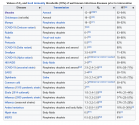If I remember correctly, according to a UK government review of multiple studies on this matter, vaccination does play a big role in reducing ones chances of getting Covid. However (please correct me if I am wrong), the probability of getting long Covid is from 21 - 50% (review link: ):Even if you are tripple jabbed with Pfizer/Moderna/J&J, the antibody counts wane over time (~6 mons), and new variants can breakthrough infection, and significant # of children are not even vaccinated.
So I think China eventually needs to realize, even triple/quadruple vaccinated best mRNA will be breakthrough cases, why not focus on antibody cocktails and antiviral drugs to treat these breakthrough cases if they are severe enough for hospitalization and prevent death? The goal should not be preventing infections, but preventing hospitalization and preventing deaths.
As for the long COVID concern, studies have shown that being vaccinated significantly reduces probability of long COVID compared to unvaccinated.
Fully vaccinated participants were about half as likely to have symptoms lasting ≥28 days than unvaccinated participants (odds ratio [OR] = 0.51, 95% CI: 0.32 to 0.82, p=0.005), whereas partially vaccinated participants were about as likely to have symptoms lasting ≥28 days than unvaccinated participants (OR = 1.04, 95% CI: 0.86 to 1.25, p=0.69).
• Fully vaccinated younger adults (18 to 59 years) were much less likely to have symptoms lasting ≥28 days than younger unvaccinated adults (OR = 0.21, 95% CI: 0.08 to 0.59, p=0.003).
Assuming the above is true and everyone gets Covid, if at least 21% of the Chinese populace is at least affected, the economic cost for the country would most likely be high since they can’t work. Fortunately, China isn’t as reliant on exports as before, so China can brunt the temporary economic pain of lockdowns. As long as China doesn’t rely on exports, China can easily take the hits from those lockdowns. China needs to really research the cause behind long covid and, like what you said, antiviral drugs and antibody cocktails. If the cause and the treatment can be identified for this issue, China would no longer need lockdowns. I believe they are most likely doing that, so we’ll just need to wait and see.
The only thing China needs to realize is that the one country two systems concept for HK is a catostrophic failure. The current surge was ultimately caused by Hong Kong’s negligence and incompetence. If there is anything that needs to be changed, it’s Hong Kong.
Last edited:

